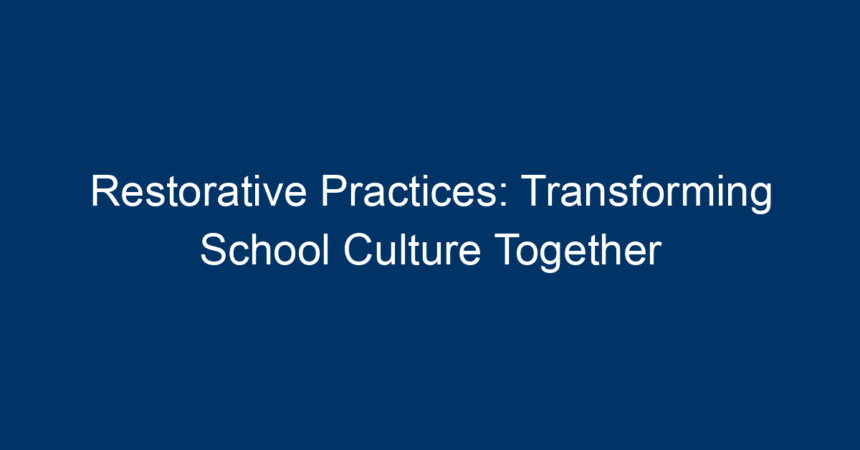In an era where school discipline strategies often emphasize punishment over understanding, a paradigm shift towards restorative practices is taking place. This innovative approach seeks to foster healthy, supportive school cultures by focusing on relationships, community, and healing rather than simply administering consequences. As educators, students, and parents come together to embrace restorative practices, schools can transform into nurturing environments where every voice is heard.
Understanding Restorative Practices
At its core, restorative practices are grounded in the principles of respect, responsibility, and community. Unlike traditional disciplinary methods that often lead to exclusion or isolation, restorative practices prioritize dialogue and understanding. The goal is to address harm by repairing relationships and creating a sense of belonging among students.
The Roots of Restorative Practices
Originating from indigenous justice systems, restorative practices have evolved into an educational approach that emphasizes community and connection. This framework encourages students to engage in open conversations about their behavior and its impact on others. By fostering empathy and accountability, restorative practices not only resolve conflicts but also enhance the overall school climate.
Key Components of Restorative Practices
Restorative practices encompass various strategies and techniques designed to facilitate healing and collaboration. Here are some of the key components:
-
Restorative Circles: These structured meetings engage students in discussions about behavior and its effects. By encouraging open dialogue, restorative circles help build trust and understanding within the community.
-
Peer Mediation: This concept empowers students to resolve conflicts among themselves. Trained mediators guide conversations, enabling peers to express their feelings and work towards mutual solutions.
-
Restorative Conferencing: This formal meeting involves the harmed party, the offender, and community representatives. The aim is to collaboratively discuss the incident, its impact, and how to make amends.
- Community Building: Regular activities designed to enhance relationships among students and staff create a positive school culture. These activities promote empathy, shared values, and a sense of unity.
Benefits of Implementing Restorative Practices
Transitioning to restorative practices can yield significant benefits for both students and educators, including:
Improved Relationships
Restorative practices prioritize relationship-building, which can lead to stronger connections among students and between students and staff. These improved relationships create an environment where students feel valued and understood.
Reduced Behavioral Issues
Research indicates that schools implementing restorative practices have experienced a decline in punishments and suspensions. By addressing the underlying causes of conflicts, schools can reduce the frequency of behavioral issues.
Enhanced Academic Performance
A positive school culture fosters engagement and motivation among students. When students feel safe and supported, they are more likely to excel academically. Restorative practices create an environment conducive to learning, enabling students to reach their full potential.
Increased Student Voice and Agency
Restorative practices empower students by giving them a platform to voice their opinions and contribute to the decision-making process. This sense of agency encourages students to take responsibility for their actions and helps them better understand the impact of those actions on their peers.
Implementing Restorative Practices in Schools
Transitioning to restorative practices requires a thoughtful approach and collaboration among all stakeholders. Here are actionable steps schools can take:
1. Training and Professional Development
Investing in professional development is crucial for staff members to understand the principles and techniques of restorative practices. Workshops, training sessions, and ongoing support can equip educators with the necessary skills to implement these practices effectively.
2. Engaging the Community
Involving parents, guardians, and community members in the implementation process fosters a sense of ownership and support. Host community meetings to explain the goals of restorative practices and how families can contribute to a positive school culture.
3. Creating a Restorative Practice Team
Forming a dedicated team of educators, counselors, and community stakeholders can help oversee the implementation process. This team can lead discussions, facilitate training sessions, and monitor the effectiveness of restorative practices.
4. Monitoring and Evaluation
Regularly assess the impact of restorative practices on school culture by gathering feedback from students, staff, and families. Use surveys, focus groups, and observation to gauge the effectiveness of the initiatives and make necessary adjustments.
5. Celebrating Successes
Acknowledge and celebrate the successes achieved through restorative practices, whether big or small. Recognizing positive changes can motivate the entire school community to continue working toward a restorative culture.
Challenges in Implementing Restorative Practices
While the benefits of restorative practices are clear, several challenges may arise during implementation:
Resistance to Change
Many educators and community members may be accustomed to traditional disciplinary methods and may resist the shift to restorative practices. Providing education and ongoing support can alleviate concerns.
Time Constraints
Implementing restorative practices may require additional time for training, meetings, and community engagement. Schools must allocate adequate resources to ensure these efforts are successful.
Inconsistent Application
For restorative practices to be effective, they must be consistently applied across the school. This requires a committed effort from all staff members to ensure that practices are uniformly enforced and respected.
Conclusion: Building a Brighter Future
Restorative practices offer a transformative approach to school discipline that can reshape the educational landscape. By prioritizing relationships over punishment, schools can cultivate communities where students feel secure, respected, and motivated to learn.
As stakeholders come together to embrace restorative practices, they can pave the way for an inclusive school culture that nurtures growth and collaboration. Ultimately, the successful implementation of restorative practices depends on continuous commitment, analysis, and adaptation. By investing in restorative practices today, schools can build a brighter future for their students and communities.
Actionable Insights
-
Start Small: Introduce one restorative practice, like circles, in a single classroom to gauge impact before scaling.
-
Enhance Communication: Open channels for feedback from students and parents to foster a collaborative environment.
- Share Success Stories: Highlight instances where restorative practices led to positive outcomes to inspire others.
By committing to restorative practices, schools can create environments where every student thrives, ultimately transforming school culture together.




